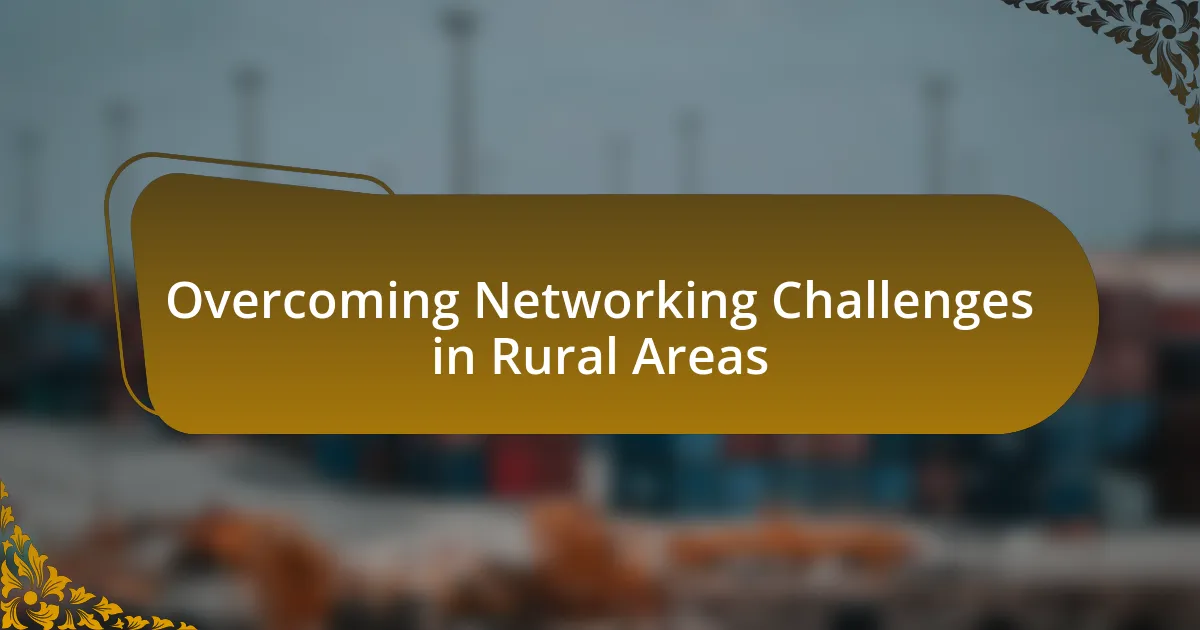The article focuses on overcoming networking challenges in rural areas, highlighting key issues such as limited infrastructure, low population density, and high deployment costs that hinder reliable internet access. It examines the impact of geographical factors, technological limitations, and social dynamics on connectivity, while also discussing the role of community engagement and education in addressing these barriers. Strategies for improvement include enhancing infrastructure, leveraging community partnerships, and utilizing innovative technologies. The article emphasizes the importance of collaboration between public and private sectors, as well as the benefits of community-driven approaches and successful case studies that can serve as models for other rural regions facing similar challenges.

What are the key networking challenges faced in rural areas?
The key networking challenges faced in rural areas include limited infrastructure, low population density, and high costs of deployment. Limited infrastructure often results in inadequate broadband access, with many rural communities lacking reliable internet service. The low population density makes it economically unfeasible for service providers to invest in extensive network infrastructure, leading to fewer options for consumers. High deployment costs further exacerbate the issue, as providers face significant expenses in reaching remote locations, which can deter investment. According to the Federal Communications Commission, approximately 19 million Americans in rural areas lack access to high-speed internet, highlighting the severity of these challenges.
How do geographical factors impact networking in rural regions?
Geographical factors significantly impact networking in rural regions by limiting access to infrastructure and resources essential for effective communication. In rural areas, the sparse population density often results in inadequate internet connectivity and fewer telecommunications facilities, which hinders the establishment of robust networking systems. For instance, according to the Federal Communications Commission, as of 2021, approximately 14 million Americans in rural areas lack access to high-speed internet, which directly affects their ability to connect with others and access online resources. Additionally, geographical isolation can lead to a lack of local networking events and opportunities, further exacerbating the challenges faced by individuals and businesses in these regions.
What specific geographical barriers hinder network connectivity?
Specific geographical barriers that hinder network connectivity include mountains, dense forests, rivers, and remote locations. These natural features obstruct signal transmission and infrastructure development, making it difficult to establish reliable network connections. For instance, mountainous terrain can block line-of-sight communication essential for wireless networks, while dense forests can absorb signals and reduce coverage. Additionally, rivers and other bodies of water may require costly infrastructure solutions, such as bridges or underwater cables, to connect networks on either side. Remote locations often lack the economic incentive for service providers to invest in necessary infrastructure, further exacerbating connectivity issues.
How does population density influence networking infrastructure?
Population density significantly influences networking infrastructure by determining the demand for connectivity and the feasibility of deploying network resources. In densely populated areas, the high demand for internet and telecommunications services justifies the investment in advanced networking infrastructure, such as fiber-optic cables and 5G technology. For instance, urban regions with over 1,000 people per square mile often see multiple service providers competing, leading to improved service quality and coverage. Conversely, in sparsely populated rural areas, where the density may drop below 100 people per square mile, the lower demand makes it economically challenging to justify similar investments, resulting in limited access to high-speed internet and outdated infrastructure. This disparity highlights how population density directly correlates with the availability and quality of networking infrastructure.
What technological limitations exist in rural networking?
Technological limitations in rural networking primarily include inadequate infrastructure, limited bandwidth, and high latency. In many rural areas, the lack of physical infrastructure such as fiber optic cables and cellular towers restricts access to high-speed internet. According to the Federal Communications Commission (FCC), approximately 19 million Americans in rural areas lack access to broadband, which is defined as internet speeds of 25 Mbps download and 3 Mbps upload. Additionally, the available bandwidth in these regions is often insufficient to support multiple users or high-demand applications, leading to slower speeds and unreliable connections. High latency is another issue, as the distance from urban centers can result in delays in data transmission, further hindering effective communication and online activities. These factors collectively contribute to the challenges faced in establishing reliable and efficient networking in rural areas.
What types of technology are commonly used in rural networking?
Common technologies used in rural networking include satellite internet, fixed wireless, and fiber-optic connections. Satellite internet provides coverage in remote areas where traditional infrastructure is lacking, enabling connectivity through satellites orbiting the Earth. Fixed wireless technology utilizes radio signals to connect rural users to the internet via a base station, which is particularly effective in areas with limited physical infrastructure. Fiber-optic connections, while more expensive to deploy, offer high-speed internet access and are increasingly being installed in rural regions to enhance connectivity. These technologies collectively address the unique challenges of providing reliable internet access in rural settings.
How do bandwidth and speed limitations affect rural users?
Bandwidth and speed limitations significantly hinder rural users by restricting their access to reliable internet services. These limitations result in slower download and upload speeds, making it difficult for users to engage in activities such as streaming, online education, and telecommuting. According to the Federal Communications Commission (FCC), approximately 25% of rural Americans lack access to broadband speeds of 25 Mbps download and 3 Mbps upload, which are considered the minimum for effective online use. This lack of adequate bandwidth leads to increased latency and connectivity issues, further isolating rural communities from essential services and opportunities available in urban areas.
What social factors contribute to networking challenges in rural areas?
Social factors that contribute to networking challenges in rural areas include limited population density, lack of access to resources, and social isolation. Limited population density reduces opportunities for face-to-face interactions, making it difficult for individuals to establish and maintain professional relationships. Additionally, rural areas often lack essential resources such as high-speed internet and community centers, which can hinder networking efforts. Social isolation, stemming from geographical distance and fewer social events, further exacerbates the difficulty in forming connections, as individuals may feel disconnected from broader professional networks.
How does community engagement affect networking solutions?
Community engagement significantly enhances networking solutions by fostering collaboration and resource sharing among local stakeholders. When communities actively participate in the development and implementation of networking solutions, they can identify specific needs and challenges unique to their area, leading to more tailored and effective solutions. For instance, a study by the Pew Research Center found that community-driven initiatives in rural areas often result in increased internet access and improved service quality, as local input helps prioritize infrastructure investments. This collaborative approach not only builds trust among community members but also encourages sustainable practices, ensuring that networking solutions are maintained and adapted over time to meet evolving needs.
What role does education play in overcoming networking barriers?
Education plays a crucial role in overcoming networking barriers by equipping individuals with the skills and knowledge necessary to build and maintain professional relationships. Specifically, education fosters communication skills, enhances digital literacy, and provides access to resources that facilitate networking opportunities. For instance, studies have shown that individuals with higher education levels are more likely to engage in networking activities, as they possess the confidence and competence to connect with others in their field. Additionally, educational institutions often provide platforms for networking, such as workshops, seminars, and alumni events, which further bridge the gap in networking capabilities, particularly in rural areas where access to professional networks may be limited.

What strategies can be employed to overcome networking challenges in rural areas?
To overcome networking challenges in rural areas, strategies such as enhancing infrastructure, leveraging community partnerships, and utilizing technology can be employed. Enhancing infrastructure involves investing in high-speed internet and mobile connectivity, which is crucial as studies show that rural areas often lack adequate broadband access, affecting economic growth and education. Leveraging community partnerships can facilitate resource sharing and collaborative projects, as evidenced by initiatives like the Rural Broadband Initiative, which brings together local governments, businesses, and non-profits to improve connectivity. Utilizing technology, such as satellite internet and mesh networks, can provide alternative solutions where traditional infrastructure is lacking, as demonstrated by successful implementations in various rural communities.
How can local governments support rural networking initiatives?
Local governments can support rural networking initiatives by providing funding, resources, and infrastructure development. For instance, they can allocate grants specifically for technology upgrades, such as broadband expansion, which is crucial for effective networking in rural areas. According to the Federal Communications Commission, approximately 19 million Americans lack access to high-speed internet, highlighting the need for local governments to prioritize connectivity. Additionally, local governments can facilitate partnerships between community organizations and private sector entities to foster collaborative networking efforts, thereby enhancing social and economic opportunities in rural communities.
What policies can be implemented to improve infrastructure?
To improve infrastructure in rural areas, policies should focus on increasing funding for transportation, broadband access, and utility services. For instance, the federal government can allocate grants specifically for rural infrastructure projects, as seen in the Infrastructure Investment and Jobs Act of 2021, which earmarked $65 billion for broadband expansion. Additionally, implementing tax incentives for private companies to invest in rural infrastructure can stimulate economic growth and enhance connectivity. Evidence from the National Rural Electric Cooperative Association shows that rural electrification initiatives have significantly improved quality of life and economic opportunities in underserved areas.
How can funding be secured for rural networking projects?
Funding for rural networking projects can be secured through a combination of government grants, private investments, and community partnerships. Government programs, such as the USDA’s Rural Development initiatives, provide financial assistance specifically aimed at improving rural infrastructure, including broadband access. Additionally, private sector investments from telecommunications companies often target underserved areas to expand their market reach, while community partnerships can leverage local resources and support to enhance project viability. For instance, the Federal Communications Commission’s (FCC) Rural Digital Opportunity Fund allocates $20.4 billion to support broadband deployment in rural areas, demonstrating a significant commitment to funding these essential projects.
What role do private companies play in enhancing rural networking?
Private companies play a crucial role in enhancing rural networking by providing infrastructure, technology, and services that improve connectivity. These companies often invest in building telecommunications networks, such as fiber-optic cables and wireless towers, which are essential for internet access in underserved areas. For instance, according to a report by the Federal Communications Commission, private sector investments accounted for over 90% of the funding for broadband expansion in rural America between 2015 and 2020. Additionally, private companies often partner with local governments and organizations to implement innovative solutions tailored to the specific needs of rural communities, thereby facilitating better access to information and resources.
How can partnerships between public and private sectors be formed?
Partnerships between public and private sectors can be formed through collaborative initiatives that align mutual interests and resources. These partnerships often begin with identifying common goals, such as improving infrastructure or enhancing service delivery in rural areas. For instance, public agencies can engage private companies by offering incentives like tax breaks or grants, which encourage investment in local projects. A successful example is the collaboration between local governments and telecommunications companies to expand internet access in underserved regions, demonstrating how shared objectives can lead to effective partnerships.
What innovative solutions have been successfully implemented by companies?
Companies have successfully implemented innovative solutions such as satellite internet and community mesh networks to overcome networking challenges in rural areas. For instance, SpaceX’s Starlink provides high-speed satellite internet, enabling connectivity in remote locations where traditional broadband is unavailable. Additionally, companies like Google have developed community mesh networks, allowing residents to share internet access, thereby enhancing connectivity and reducing costs. These solutions have proven effective in bridging the digital divide, as evidenced by increased internet access in previously underserved regions.
How can community-driven approaches improve networking in rural areas?
Community-driven approaches can significantly improve networking in rural areas by fostering collaboration and building trust among residents. These approaches encourage local participation in decision-making processes, which enhances social cohesion and creates a supportive environment for networking. For instance, initiatives like community workshops or local business fairs facilitate connections among individuals and organizations, leading to shared resources and knowledge. Research indicates that communities with strong social networks experience increased economic resilience, as evidenced by a study from the Rural Policy Research Institute, which found that rural areas with active community engagement saw a 20% increase in local business collaborations. This demonstrates that community-driven strategies not only enhance networking but also contribute to the overall economic vitality of rural regions.
What are the benefits of community-owned networks?
Community-owned networks provide enhanced local control over internet services, leading to improved access and affordability for residents. These networks often prioritize community needs, resulting in tailored services that larger providers may overlook. For instance, studies show that community-owned networks can offer lower prices and better customer service, as they are directly accountable to their users. Additionally, they foster local economic development by enabling small businesses and attracting new investments, as evidenced by successful models in various rural areas across the United States.
How can local residents be trained to maintain networking systems?
Local residents can be trained to maintain networking systems through structured educational programs that focus on practical skills and theoretical knowledge. These programs should include hands-on workshops, online courses, and community training sessions that cover topics such as network configuration, troubleshooting, and basic cybersecurity measures. Evidence from successful initiatives, such as the Community Technology Centers program in the United States, shows that local training can significantly enhance residents’ technical capabilities, leading to improved network reliability and performance in rural areas.

What are the best practices for ensuring effective networking in rural areas?
The best practices for ensuring effective networking in rural areas include leveraging local community events, utilizing digital platforms, and fostering partnerships with local organizations. Community events, such as fairs and workshops, provide opportunities for face-to-face interactions, which are crucial for building trust and relationships. Digital platforms, like social media and professional networking sites, can help connect individuals across distances, facilitating communication and collaboration. Additionally, partnerships with local organizations, such as schools, businesses, and non-profits, can enhance resource sharing and create a supportive network. These practices are supported by studies indicating that community engagement and digital connectivity significantly improve networking outcomes in rural settings.
What steps can individuals take to improve their own networking access?
Individuals can improve their networking access by actively participating in local community events and leveraging online platforms. Engaging in community events, such as workshops or meetups, fosters face-to-face connections that can lead to valuable networking opportunities. Additionally, utilizing online platforms like LinkedIn or local Facebook groups allows individuals to connect with professionals in their field, regardless of geographical limitations. Research indicates that 70% of jobs are found through networking, highlighting the importance of building relationships both in-person and online.
How can residents advocate for better networking services?
Residents can advocate for better networking services by organizing community meetings to discuss connectivity issues and collectively approach local government representatives. This grassroots effort can lead to increased awareness of the need for improved infrastructure, as evidenced by studies showing that community advocacy can significantly influence policy decisions. For instance, a report from the Federal Communications Commission highlights that community-led initiatives have successfully secured funding for broadband expansion in underserved areas. By presenting data on current service gaps and potential economic benefits of enhanced networking services, residents can strengthen their case for better connectivity.
What resources are available for rural residents to enhance connectivity?
Rural residents can enhance connectivity through various resources such as government programs, community initiatives, and technology solutions. The Federal Communications Commission (FCC) offers initiatives like the Rural Digital Opportunity Fund, which allocates billions to improve broadband access in underserved areas. Additionally, local cooperatives and non-profits often provide internet services tailored to rural needs, such as fiber-optic networks. According to a 2021 report by the Pew Research Center, approximately 70% of rural Americans have access to high-speed internet, indicating ongoing improvements in connectivity resources.
What lessons can be learned from successful rural networking projects?
Successful rural networking projects demonstrate the importance of community engagement and collaboration. These projects often succeed by involving local stakeholders in the planning and implementation phases, ensuring that the solutions address specific community needs. For instance, the Rural Broadband Initiative in the United States highlighted that projects with strong local partnerships achieved higher adoption rates, as they tailored services to the unique characteristics of rural populations. Additionally, successful projects emphasize the need for sustainable funding models, as seen in the case of the Connect America Fund, which provided financial support to expand broadband access in underserved areas. These lessons underscore that effective rural networking relies on local involvement and sustainable financial strategies to overcome inherent challenges.
What case studies highlight effective rural networking solutions?
Case studies that highlight effective rural networking solutions include the “ConnectHome” initiative and the “Rural Broadband Initiative.” The ConnectHome program, launched by the U.S. Department of Housing and Urban Development, aimed to provide high-speed internet access to low-income families in public housing across 28 communities, resulting in increased digital literacy and access to online resources. The Rural Broadband Initiative, implemented in various states, focused on expanding broadband infrastructure through partnerships with local governments and private companies, leading to improved connectivity for over 1 million rural residents. These case studies demonstrate successful strategies for overcoming networking challenges in rural areas by enhancing access to technology and fostering community collaboration.
How can these lessons be applied to other rural areas facing similar challenges?
Lessons learned from overcoming networking challenges in specific rural areas can be applied to other rural regions by implementing community-driven initiatives that focus on collaboration and resource sharing. For instance, establishing local partnerships among residents, businesses, and government entities can enhance access to technology and infrastructure, as demonstrated by successful case studies where rural communities increased internet access through cooperative models. Additionally, leveraging existing local knowledge and skills can foster innovative solutions tailored to the unique needs of each area, as evidenced by programs that have effectively utilized local talent to address connectivity issues. These strategies not only promote resilience but also empower communities to tackle similar challenges collectively.
What practical tips can help communities overcome networking challenges?
Communities can overcome networking challenges by fostering collaboration through regular meetings and events that encourage relationship-building among members. Establishing a local network or coalition can facilitate resource sharing and collective problem-solving, which is essential in rural areas where access to services may be limited. Additionally, leveraging technology, such as social media platforms and community forums, can enhance communication and engagement, allowing members to connect and share information more effectively. Research indicates that communities with strong social networks experience improved access to resources and support, highlighting the importance of these strategies in overcoming networking challenges.
